
Development of Online Course Application with Ruby on Rails
framework
Major project report submitted in partial fulfillment of the requirement for the degree of
Bachelor of Technology
in
Computer Science and Engineering
By
ANURAG KANAUJIA (181363)
UNDER THE SUPERVISION OF
Dr. RAVINDARA BHATT
Department of Computer Science & Engineering and Information
Technology
Jaypee University of Information Technology, Waknaghat, 173234, Himachal
Pradesh, INDIA

DECLARATION
We hereby declare that this project has been done by us under the supervision of Dr. Ravindara Bhatt,
Associate Prof, Department of CSE Jaypee University Of Information Technology. We also declare that
neither this project nor any part of this project has been submitted elsewhere for the award of any degree or
diploma.
Supervised by:
Dr. Ravindara Bhatt
Associate Prof
Department of Computer Science & Engineering And Information Technology
Jaypee University Of Information Technology
Anurag Kanaujia
(181363)
Department of CSE
Jaypee University of Information Technology

CERTIFICATE
This is to certify that the work which is being presented in the project report titled “Development of Online
Course Application with Ruby on Rails framework” in partial fulfillment of the requirements for the award
of the degree of B.Tech in Computer Science And Engineering and submitted to the Department of Computer
Science And Engineering, Jaypee University of Information Technology, Waknaghat is an authentic record of
work carried out by “Anurag Kanaujia (181363)” during the period from February 2022 to May 2022 under
the supervision of Dr. Ravindara Bhatt, Department of Computer Science And Engineering, Jaypee
University of Information Technology, Waknaghat.
Anurag Kanaujia
(181363)
The above statement made is correct to the best of my knowledge.
Dr. Ravindara Bhatt
Professor
Computer Science & Engineering And Information Technology
Jaypee University of Information Technology, Waknaghat, India
Dated:

ACKNOWLEDGMENT
First We express our heartiest thanks and gratefulness to Almighty God for His divine blessing makes us
possible to complete the project successfully.
We are grateful and wish my profound indebtedness to Dr. Ravindara Bhatt, Associate Prof, Department of
CSE Jaypee University Of Information Technology, Wakhnaghat. Deep Knowledge & keen interest of my
supervisor in the field of “Development of Online Course Application with Ruby on Rails framework” to
carry out this project. His endless patience, scholarly guidance, continual encouragement, constant and
energetic supervision, constructive criticism, valuable advice, reading many inferior drafts, and correcting
them at all stages have made it possible to complete this project.
We would like to express my heartiest gratitude to Dr. Ravindara Bhatt, Department of CSE, for his kind
help to finish my project.
We would also generously welcome each one of those individuals who have helped us straightforwardly or in
a roundabout way in making this project a win. In this unique situation, We might want to thank the various
staff individuals, both educating and non-instructing, which have developed their convenient help and
facilitated my undertaking.
Finally, We must acknowledge with due respect the constant support and patients of my parents.
Anurag Kanaujia
(181363)

ABSTRACT
This thesis discusses developmental steps for web-based courses, an app that allows the user to log in,
Subscribe to the tutorial and see its chapter on smart content similar to what Udemy does with some additional
features and support. Describes in detail the implementation of the application at the end and back. Thesis is
possible designed and explained how to improve a web application using Ruby on Rails technology.

LIST OF FIGURES
Fig. 2.1 The Model View Controller architecture 9
Fig. 2.2 Architecture of standard Ruby on Rails web application 12
Fig. 3.1 Visual overview of a Three-tiered Web Application 19
Fig. 3.2 High-level view of the Online Course application. 20
Fig 3.3 Model-View-Controller Architecture of the online course application 21
Fig 3.4 DB design for online course application 25
Fig 3.5 POST search/topics 30
Fig 3.6 POST /topic/:slug/courses 31
Fig 3.7 POST search/courses 32
Fig 3.8 GET course/:slug/modules 33
1

2

1. INTRODUCTION
The online course application aims at supporting application users in learning and achieving numerous skills
by providing different course contents and a user friendly interface. The application interacts with the users
through a website, which is always available via the Internet. The project is divided into two functional
blocks: the application front-end and the application back-end.
Application Front-end The front end of the online course application is the user interface. The website page
is the application interface through which users can interact with the course. You can log in using your email
address and app password. You can register for courses, study different chapters, watch videos, and take notes
on videos.
Application Back-end The backend of the application consists of a relational database with various database
tables where user data is stored and from which user data is retrieved. When a community user submits a
request, the request value is validated, structured on the front end, and sent to the back end. The database
processes these values and responds to the user interface.
3

1.1 Problem Statement
In the 21st century, education has undergone new changes with the advancement of technology. The way we
read has also changed, so the way we read has changed a lot. Technology is being introduced into the
education system and distance learning, online classes and online courses are becoming the norm. There are
various forums today that offer many options to learn about a variety of topics. Some of them are free, others
require a subscription to access the full curriculum. Improved online forums that have emerged over the past
few years have led to improved levels of learning.
Online courses allow anyone to sit down and learn a new skill or hone an existing one. Learning new skills
expands your repertoire and improves your professional skills. Employers will appreciate if you take the time
to hone your skills and keep up with the times. Studying at home with an online course has its advantages.
Online courses can not only benefit students but also the working professionals,
They can be extremely beneficial for them as they want to learn new skills which are either for their career
growth, personal development or just for fun and don’t want to commute.
4

1.2 Objectives
The goal of this project is to develop and implement a prototype online tutorial using Ruby on Rails
technology. The visual user of the application is responsible for managing all user requests, filtering input,
submitting requests to the website, managing feedback from the website, filtering responses, and sending web
interactions to the user. This is the main feature of the report and we will focus on developing web
applications using the Ruby on Rails framework.
The Target Audience
The intended audience for this report is students and practitioners. The concept of online learning allows
students to learn from home or any other convenient location. They can find learning materials on the Internet.
Textbooks for online learning can be texts, audio recordings, notes, videos, and images.
5

1.3 Organization
About InterviewBit/ Scaler
Scaler Academy is an online technical college for the world's leading software developers. They offer an
in-depth six-month computer science course in the form of live lessons taught by top tech experts and subject
matter experts. Well-planned programs enhance the skills of software professionals by providing a
state-of-the-art curriculum that uses the latest technologies. This is an interview bit product.
Founders
Scaler Academy (and InterviewBit) was founded by IIIT Hyderabad graduates Anshuman Singh and
Abhimanyu Saksena.
Anshuman previously worked at Facebook, leading the team, creating and measuring Messenger features.
Anshuman is also part of a team of four that will set up Facebook's London office. He competed and made it
to the ACM ICPC World Finalist twice. Abhimanyu led the team that designed the entire New York market
for Fab.com. A longtime businessman, Abhimanyu started his first business while in college.
What do they do
Scaler Academy is an online acceleration program that successfully develops the skills of software
programmers. We educate students on all the relevant skills needed in the software industry, advise on the
recruitment process and align with the best software industry employment opportunities around the world.
Academy students spend an average of 35 hours each day on the platform learning and practicing their skills.
Give students access to more than 400 professionals from top software companies such as Facebook, Amazon,
Google, Directi, and Microsoft, who are active as educators, mentors, teaching assistants, and career coaches.
Prominent executives such as Bavin Turakhia (Co-founder and CEO of Directi Group and Zeta), Rajan
Anandan (former Google Head of APAC), and Jason Goldberg (CEO of Fab.com) are among the individuals
who guide scaler students. It is a department.
6

Why do they do
InterviewBit does little to help young professionals improve their opportunities to work with leading
technology companies. Since 2015, we have transformed the lives of more than 4,000 young professionals by
helping leading technology companies find their dreams. Currently, more than 600 companies outsource the
recruitment of professionals. Most of the people we deal with have seen early on that they can accomplish
even greater things if given the right guidance. What was lacking was not only teaching new skills, but also
access to teachers and mentors to guide their careers. For this reason, we launched the Scaler Academy in
April 2019. We are confident that talented people will be able to realize their dreams by bridging the gap
between their theatrical knowledge and their thematic skills. And the Scaler Academy did just that.
7

2. LITERATURE REVIEW
2.1 Software Tools Overview
This chapter will provide a brief overview of some of the abbreviations and keywords, namely will be used
continuously in the report. The information included in this section is intended to makes reading this report
easier for the reader to follow
2.1.1 Web application
A web application (web application) is an application program that is stored on a remote server and served
over the Internet via a browser interface. Web services are, by definition, web apps, and many, if not all,
websites include web apps. According to Jarel Remick, the Web.AppStorm editor, any website component
that performs a function for a user is considered a web app.
Web applications can be designed for a variety of purposes and can be used by anyone. From organization to
individual for a variety of reasons. Commonly used web applications include webmail, online calculators, or
e-commerce stores. Some web apps can only be accessed from certain browsers. However, most are available
regardless of browser.
2.1.2 Online community
An online community or community that is visible to a group of people in particular use social media such as
email, an internet communication service or instant messaging rather than face to face, social, professional,
educational or other purposes. Today visible communities and the internet have become a
a method of communication between people who share the same businesses
interests, hobbies or friendships.
2.1.3 Web Framework
8

A web application (web application) is an application program that is stored on a remote server and served
over the Internet via a browser interface. Web services are, by definition, web apps, and many, if not all,
websites include web apps. According to Jarel Remick, the Web.AppStorm editor, any website component
that performs a function for a user is considered a web app.
Web applications can be designed for a variety of purposes and can be used by anyone. From organization to
individual for a variety of reasons. Commonly used web applications include webmail, online calculators, or
e-commerce stores. Some web apps can only be accessed from certain browsers. However, most are available
regardless of browser.
Fig. 2.1 The Model View Controller architecture
2.1.4 Don't Repeat Yourself
The Don't Repeat Yourself (DRY) principle states that logic duplication should be eliminated by abstraction.
Process duplication should be eliminated by automation. Duplication is useless. Adding unwanted code to
your code base increases the amount of work required to extend and maintain your software in the future.
9

Duplicate code contributes to technical debt. Whether the duplication is due to copy-and-paste programming
or a lack of understanding of the application of abstractions, the quality of the code is degraded. If it can be
automated, process duplication is also wasted. Manual testing, manual builds and integration processes should
be eliminated using automation wherever possible.
2.1.5 Convention over Configuration
Convention over configuration relies on developing programs using native procedures, functions, classes, and
variables in the underlying language. This approach reduces or eliminates the need for additional software
configuration files, ultimately making software development, code consistency, and maintenance easier and
faster. However, to follow these rules, software developers must be familiar with the underlying framework.
Software frameworks that support the convention approach to configuration development include Ruby on
Rails, JavaBeans, and CakePHP.
2.1.6 Representational state transfer
REST (REpresentational State Transfer) is an architectural style for providing standards between computer
systems on the Web, making it easier for systems to communicate with each other. REST-compliant systems,
often referred to as RESTful systems, are stateless and are characterized by the fact that they separate the
interests of clients and servers. Explain the meaning of these terms and why they are useful properties for
services on the web.\
Separation of Client and Server
In the REST architectural style, the client implementation and the server implementation can run
independently without knowing each other. That is, client-side code can be modified at any time without
affecting server-side operations, and server-side code can be modified without affecting client-side operations.
As long as each side knows the format of the message it sends to the other, they are modularized and kept
separate. By separating UI issues from data storage issues, you can increase UI flexibility across platforms
and improve scalability by simplifying server components. In addition, the separation of each component
allows them to be developed independently.
By using the
REST interface, different clients reach the same REST endpoint, perform the same action, and receive the
10

same response.
2.1.7 Ruby
Ruby is an open source object-oriented scripting language invented by Yukihiro Matsumoto in the mid-1990s.
Unlike languages such as C and C ++, scripting languages do not communicate directly with the hardware. It
is written to a text file, parsed by the interpreter and converted into code. These programs are generally
procedural and read from top to bottom.
On the other hand, object-oriented languages break down pieces of code into objects that can be created and
used as needed. These objects can be reused in other parts of the program and in other applications.
Yukihiro wanted to develop a scripting language that uses object-oriented programming to increase code reuse
and speed up development. And the Ruby programming language was born. It uses simple languages and
syntax to process data and logic and solve problems.
2.2 Ruby on Rails Framework
Independent programming languages which doesn't include high-level programming also includes ruby.
Without rails, ruby is incompatible.
Ruby on Rails is an application platform that sparks interest in Ruby and makes it popular and a compatible
with cloud computing
By many great people at ruby onrails.org, Ruby on Rails is "an open-source web framework optimized for
programmer happiness and sustainable performance".
Ruby on Rails platform has pre-built Ruby code for communication, file management, database connections,
and more. Take care of boring problems so you can focus on solving them. One of the key concepts in Rails is
Don't Repeat Yourself (DRY), which is central to the effectiveness of the framework.
There are over 1 million websites written in Ruby on Rails. There is a wide range of powerful business and
11
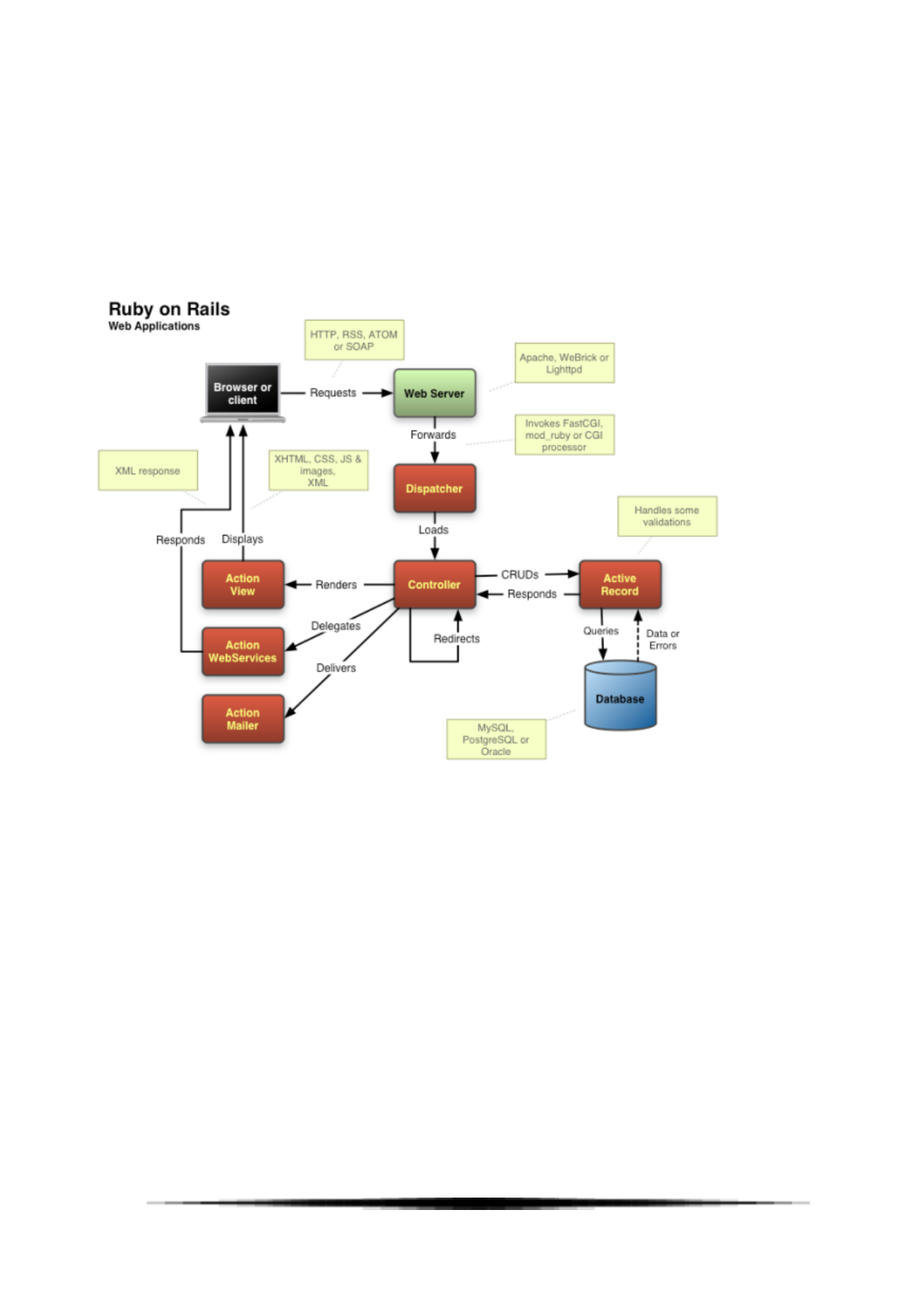
entertainment sites such as GitHub, Twitch, Bloomberg, SoundCloud, Hulu, Square, Basecamp, Airbnb, Hulu,
The Weather Channel, Instagram, and Twitter. Rails are organized around Model, View, and Controller
architecture. The benefits of MVC are to differentiate the business mindset from the user interface, save the
ZOMA application code and make it clear where different types of code belong to keep the application easy.
Figure 2.2 shows the typical design of the RoR web application.
Fig. 2.2 Architecture of standard Ruby on Rails web application
2.2.1 Models
This is called the lowest level and means that you are in charge of data maintenance. It's basically data
12

because it's logical to it. Since the model is actually connected to the database, it does anything it does with
the data. Adding or retrieving data is done in the model component. Since the controller does not interact with
the database itself, it responds to requests from the controller. The model interacts with the database and
passes the necessary data to the controller. memo. The model does not interact directly with the view.
2.2.2 Views
Data is presented as view components. You actually create a user interface or user interface. So when you
think about the view component of your web application, think about the html/css part. Views are created with
data collected from model components, but this data is not collected directly, but through controllers, so the
view only communicates with the controller.
2.2.3 Controllers
A controller is a component that provides a link between a view and a model and is known as an assistant
because it acts as an intermediary. The controller doesn't have to worry about handling the data logically, it
just tells the model what to do. After receiving data from the model, the model processes the data, extracts all
this information, and sends it to the view to tell the user how to render it. memo. Views and models cannot
speak directly.
2.2.4 Ruby on Rails Components
ROR has dozens of attachments for developing web apps. The basic structure of the ROR platform.
2.2.5 Action Controller (ActionController::Base)
The action controller is the part of the Rails application that manages the controller. The activity management
framework handles incoming requests from Rails applications, retrieves parameters and passes them to the
intended task. Actions are defined as public routes for the controller that are automatically provided to the
web server using Train Routes. The two main archetypes used for activity management are search, display,
and redirect. Many activities are variations on these themes. Services provided by Action Manager include
session management, template rendering and redirect management.
13

2.2.6 Action View (ActionView::Base)
activity view contains a view of your Rails app. It is able to automatically generate markup outputs like html
and xhtml. Action View contains basic templates and nested compressed templates, and also have built in
AJAX support. There are three ways to create a task view template. Templates that use a combination of inline
Ruby (ERb) code and HTML code have a .html.erb file extension. Templates that use the Jim Weirich
Builder::XmlMarkup library have either a .builder or .rxml file extension. Templates that use the
ActionView::Helpers::PrototypeHelper::JavaScriptGenerator module have a .rjs file extension.
Active Record (ActiveRecord::Base)
It is a highly-featured Rails Object Relational Mapping (ORM) component that requires no configuration.
Naming and conventions are important to maintaining simple and minimal code for defining classes that are
stored in database tables.
2.2.7 Action Mailer (ActionMailer::Base)
Action Mailer is a framework for creating email resources. Action Mailer can be used to send emails based on
dynamic templates or to receive and process incoming emails.
2.2.8 Active Resource (ActiveResource::Base)
Connect a business object to a Representational State Transfer (REST) web service. With ActiveResource,
you can easily expose your ActiveRecord model using REST with very little code. This is a convenient way to
create an API without much effort.
2.2.9 Active Support (ActiveSupport::Base64)
A set of useful utility classes and standard extension libraries in Rails. This extension can be useful for many
Ruby projects.
2.3 Ruby on Rails Directory Structure
14

The Rails frame takes on a specific operating time frame. Here is a sample of the high-quality indicators
produced in the creation of the railway project.
app-Organize application components. There is a subdirectory containing views (views and helpers),
controllers (controllers), and backend business logic (models).
app / controllers-Rails looks for the controller class in the controller subdirectory. The controller handles web
requests from users.
app / helpers-helpers The subdirectory contains all the helper classes used to support the Model, View, and
Controller classes. This allows you to keep your model, view, and controller code small, focused, and
organized. The
app / models-models subdirectory contains classes that model and wrap the data stored in the application's
database. In most frameworks, this part of the application is very tedious, long, verbose, and error-prone. You
can easily do it with Rails! The
app / view-views subdirectory contains view templates for entering data from the application, converting it to
HTML, and returning to the user's browser.
app / view / layouts-Contains template files for layouts used in views. It models the usual header / footer
method of wrapping a view. In the view, use layout: default to define the layout and create a file named
default.html.erb. Internal by default
Components-This directory contains small standalone applications that bundle components, models, views,
and controllers.
config-This directory contains a small amount of configuration code needed by your application, such as
database configuration (in database.yml), Rails environment structure (environment.rb), routing of incoming
web requests (routes.rb), etc. I am. .. You can also use the files in the Environments directory to customize the
behavior of the three Rails environments for testing, development, and deployment.
db-Rails applications typically have model objects that access relational database tables. You can manage
15

your relational database using a script that you create and place in this directory.
doc-Ruby has a framework called RubyDoc that can automatically generate documentation for your code.
You can support RubyDoc with comments in your code. This directory contains all rail and application
documentation generated by RubyDoc.
lib-Place the library here unless the library specifically belongs to another location (such as a vendor library).
Logs-Error logs are stored here. Rails creates scripts to help you manage various error logs. Server (server
public-Like the web server's public directory, this directory contains unchanged web files such as: B.
JavaScript files (public / javascripts), graphics (public / images), stylesheets (public / stylesheets), and HTML
files (public).
Scripts-This directory contains scripts for launching and managing various tools used by Rails. For example,
there is a script to generate code (Generate) and a script to start a web server (Server).
Tests-All the tests you create and Rails create are here. The subdirectories of Mocks, Units, Fixtures, and
Functionals are displayed.
tmp-Rails uses this directory to store temporary files for intermediate processing.
Vendors-Library provided by third parties (such as security libraries and database utilities beyond the base
Rails distribution) can be found here.
README: This file contains basic information about the Rails program and a description of the directory
listed above.
Rakefile: This file is similar to Unix Makefile which helps with creating, packaging, and scanning Rails code.
This will use the rake utility provided as well as the Ruby installation.
16

3. System Development
In this chapter the main requirements that the project has to fulfill are pointed out. The possible software
solutions are presented. The software needed for the project implementation is discussed and reasons for
choosing it is given. A discussion of the hardware requirements is made as well.
3.1 Project Analysis
The desire to design an online course web application is important because Online education enables the
teacher and the student to set their own learning pace, and there's the added flexibility of setting a schedule
that fits everyone's agenda. As a result, using an online educational platform allows for a better balance of
work and studies, so there's no need to give anything up.
Our Project targets students as well working professionals, it can contain articles, videos, quizzes and many
more things in order to engage students to try to aim for a better learning environment just like what colleges
or universities does but in a more friendly manner.
Students can interact with TA (teaching assistants) if they come up with a new
ideas or doubts meanwhile they can track the progress of their course.
Website is Divided into 4 major parts which articles, challenges, videos
that may contain inside a course which will be inside our chapter which will be belonging to particular course
for example python is a course inside python there will be chapters like loops, if/statements and inside
chapters there will be all these articles, challenges, videos lets name them entities for sake of generalization.
We will be following the best system design and structure and will remove all the redundant and unnecessary
data if they are not used. A user is able to track their progress of what course he/she watches for a better and
comfortable viewing experience.
3.2 Project Functional Requirements
Functional requirements describe the desired functions of the project, they are the core of each project and
they have an important role in the success of the project. This subchapter starts with a discussion of the main
functional needs and continues with explaining each of them in detail. As a small web course platform the
17

project needs to implement some basic features. In order to achieve a social network functionality the
application has to include user roles, profiles, semi-persistent public commentary on the profile, messaging
system and a traversable publicly articulated social network displayed in relation to the profile. Including all
these features in a web application transforms this application to a basic social network service. During the
project development additional features can be added on to expand the application functionality. In the
following section the main features are listed and discussed.
3.2.1 User Role.
The project application requires different types of users, where user role corresponds to the privileges given to
a certain user. Based on the application role users can be divided into two categories: superusers -
administrators, and normal users. Superuser is a user with extended administrative privileges. He has control
over the users in the social network. Superuser can delete, suspend or activate a normal user. Administrator
users can access every user's profile, delete messages and Requirements and photos with inappropriate content.
Normal user is a user, a member of the learning community, who can modify only his/her profile and has no
administrative privileges. A small community platform has to implement different user roles. An online course
application needs to have administrator users, who have control over the network and can make decisions
about users and their profile's content. Without user roles a small community can hardly exist and will be very
difficult to maintain.
3.3 Project Design Requirements
This project follows a three-phase client software development model. The app is divided into three sections
called "tiers". Categories are usually separate machines. The three categories include the customer category,
the application category and the website category. Client sends HTTP requests via a web browser. Web server
services request by performing queries and updates against the database server. The results are then reverted to
a web server, where the HTML visual effects are generated. The HTML template is restored to the client
browser. Figure 4.1 shows the structure of the three phases of the project.
18
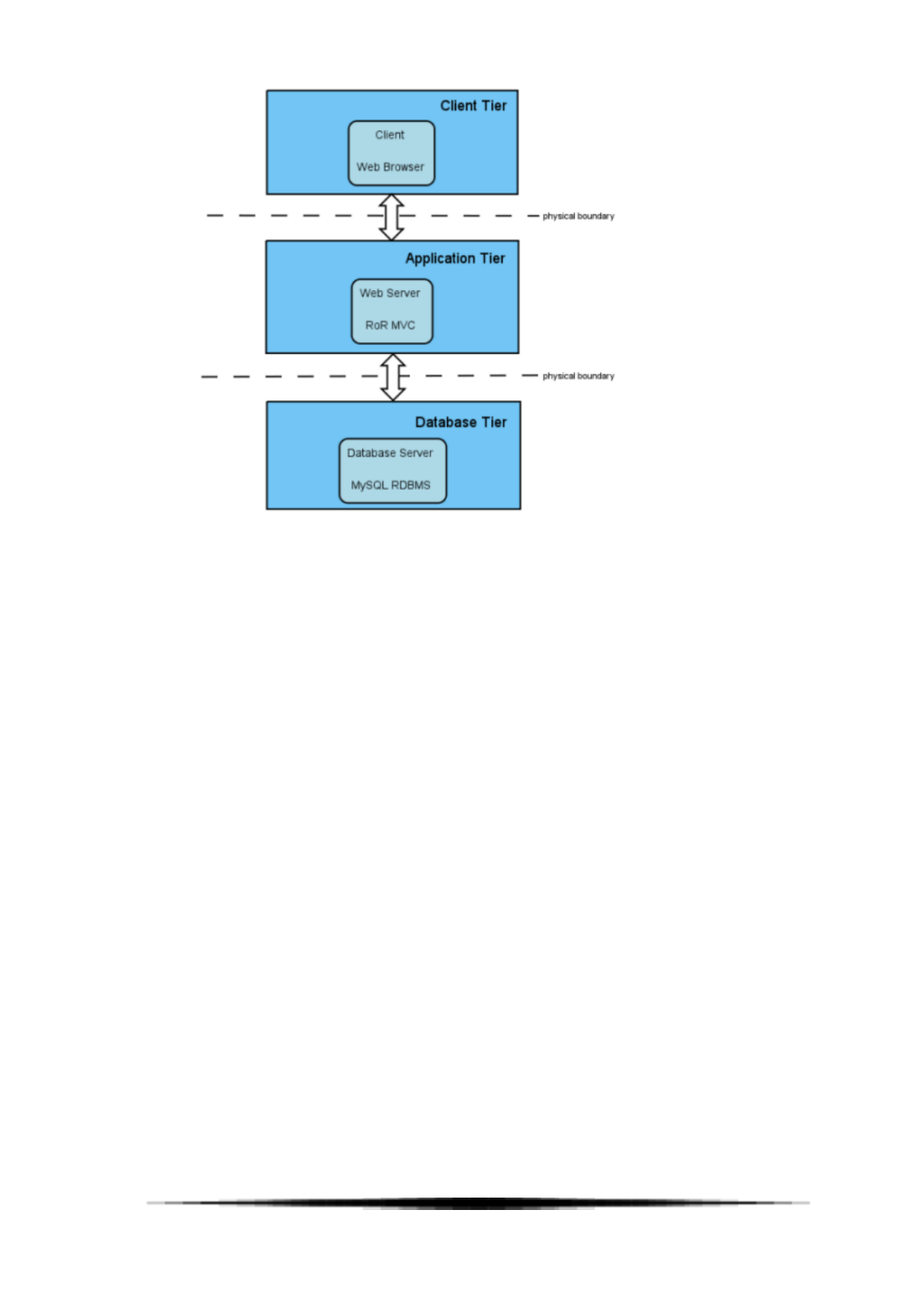
Fig. 3.1 Visual overview of a Three-tiered Web Application
Client category - the first end of the application is a web browser. Each client has its own computer with
installed operating system. The web browser is running on top of the operating system. Common operating
systems in this category include various Linux distributions such as Ubuntu, Red Hat and SUSE, Microsoft
Windows and
Mac. Typical web browsers include Mozilla Firefox, Internet Explorer, SeaMonkey, Opera, Safari.
Web Application Tier - intermediate section covers the business concept of the application. Controls
application performance by performing detailed processing. In the MVC architecture of this application, the
Application-tier is used as the viewer, controller and model layer.
Database Tier - the back end of the application contains MySQL RDBMS running on a stored server / local
server. This section stores and downloads information. The website section keeps data neutral and
independent of the business intelligence.
During the development of the Online course application, front-end and back-end are available on different
local servers.
19
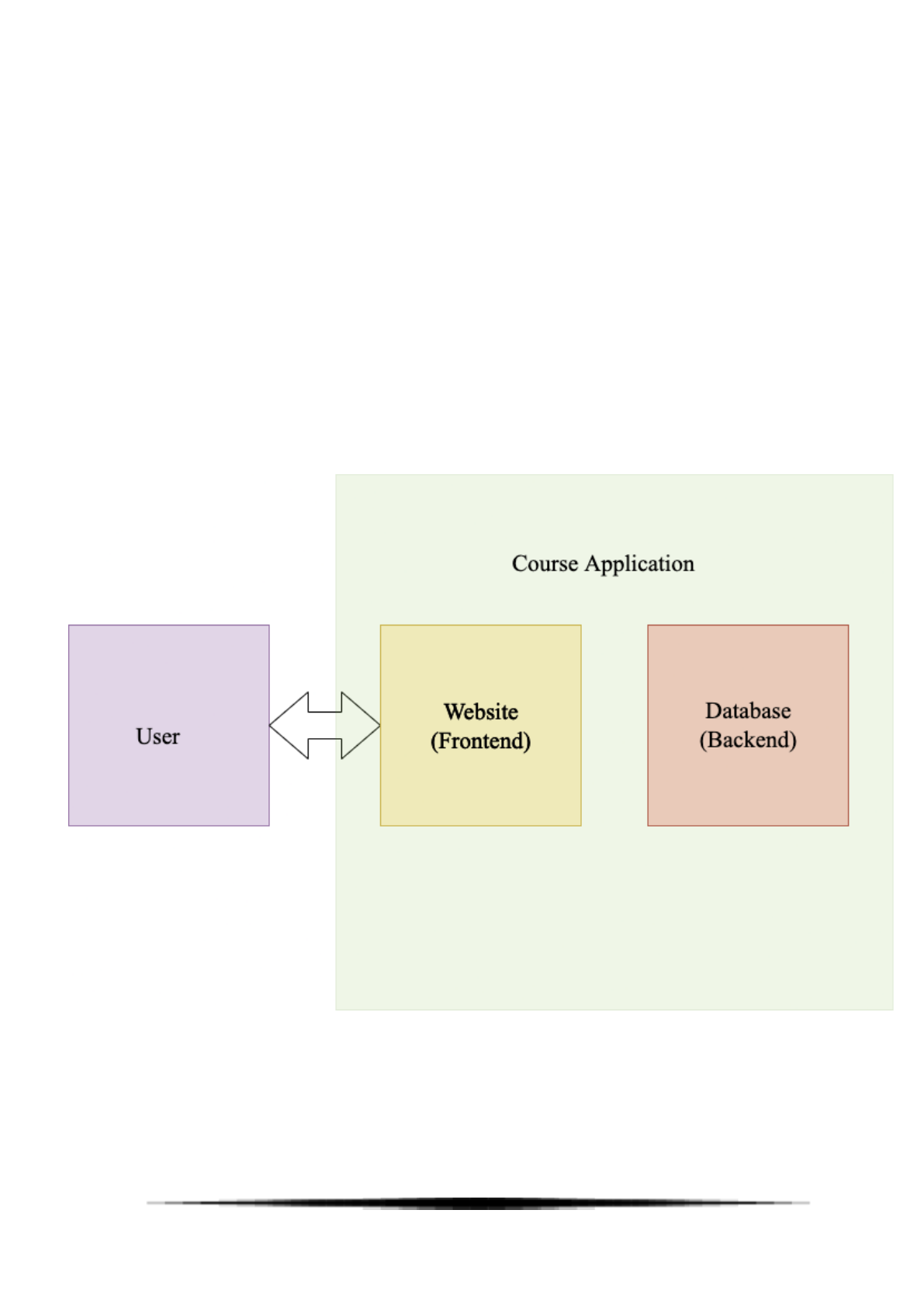
After making it clear about the functional, software and hardware requirements of the project, and having
understood the idea of the Model-View-Controller architecture, the next step is to design the web application
architecture.
3.3 Online Course Application Architecture
The application is divided into application front-end, which is the user interface, from where the user interacts
with the community platform, and application back-end, which is the database system of the platform.
Fig. 3.2 High-level view of the Online Course application.
20

Once the functional requirements are partitioned into actions of requests and responds between users and
application, the next step is to identify the business logic, presentation logic, control flow logic and model
them as objects. The following sub chapter introduces the general MVC structure design of the Web Course
application and then we will go further into internal design of each layer of the MVC to decide which objects
each layer needs.
3.4 Overview of the Application MVC Architecture
21

Fig 3.3 Model-View-Controller Architecture of the online course application
A user sends a HTTP request to the controller through the web browser. The controller receives the request,
handles the request with corresponding control logic for this specific request, and invokes a view to respond to
the user browser. The model has different objects to store different data type and objects which have business
rules to process the data. When receiving request data from a browser, data is checked for invalid input value,
refined and sent to the back-end. The response data from the back-end is as well refined and sent to the web
browser. The view is responsible for generating the user interface, normally based on data in the model. The
view includes different HTML templates and layouts, their dynamic values are the values stored in the value
objects. The object state and value can be updated.
3.5 Implementation of the Application MVC Architecture
3.5.1 The View Layer
The Ruby on Rails technology for handling user view in this online course application are rhtml templates.
Rhtml templates are a mixture of HTML and embedded Ruby (ERb). They are used to generate HTML pages.
In general, this application uses ERb for presentation of the dynamic contents and logic for presenting the
view.
There are some considerations in the view layer
• Views only have view logic.
• Inline Ruby code remains at least
• Using View Template Assistant
• Using Partial View Templates and Layouts
• View-friendly user interface
The control layer is responsible for the control logic and the model layer is defined to control the business
rules. For the background view, focus only on the logic of the presentation. Rails also has many built-in helper
modes and modules that you can use to simplify templates and incorporate complex presentation logic. Many
online tutorial pages share the same top, tail, and sidebar. You can see the same performance in many places.
Common parts and components are used to avoid duplication of design. The online course app uses two
editing styles. What registered users use is a top navigation and search bar, a center where all templates are
loaded, a sidebar on the right, and a footer at the bottom.
22

3.5.2 The Model Layer
The model layer integrates the data elements and the business concept of the application. The object-oriented
map (ORM) layer of the application. The project closely follows the standard ORM model: a map of
classrooms, rows to objects and columns in object attributes
3.5.3 The Controller Layer
MVC control layer is used for application control alignment. Controlller works with both model and view
layer. For the view background, the controller is responsible for selecting the next view. For the model
background, the controller will apply the assets to the business value and apply the business mindset
processes. For its simplicity, the web application receives an incoming request from a web browser, processes
it, and sends feedback. The controller acts as a single interface for all incoming HTTP requests from clients.
The information is encrypted in the application URL, a sub-system called “route” is used to determine what to
do with that request. The web application determines the name of the controller responsible for this particular
application, as well as the list of any other application parameters. Usually one of these additional elements
indicates the action to be applied to the targeted controller. Once the controller has been identified, a new
instance of the control panel is created, and its process is called, to transfer the request details and response
item. The controller then calls the path with the same name and action. The course of action in the controller
will require you to process business idea, review business value items and determine if the next page is back
in the browser. The config / routes.rb file contains all the application route information. The Route section
draws a map that links the external URLs of the web community application. The routes.rb file is processed
from top to bottom when the application is received. The request will be sent to the same original route. If you
do not have the same route, HTTP 404 status - An error message not found, is returned to the caller. To
achieve the required functionality of the RESTful app, Named Routes and Nest was used. A look at the config
/ routes.rb file will give the reader a brief overview of the different types of routes.
Once the route has determined which controller to use the application, the controller is responsible for making
the application concept and producing the appropriate output. The controller ensures that the model data is
available for viewing, so we can display this data to the user, and the controller is responsible for storing and
updating user data on the model.
23

3.6 Back-end - Database Design
After introducing the MVC structure design of the Web Community application, it is time to have closer look
on the database design. Developing with Rails provides a convenient way of creating, altering and managing
databases and tables by using migrations. Migrations are sub classes of ActiveRecord::Migration class and
can be found in the db/migrate directory. Creating a model class in Rails application, automatically generates
a create table migration class with two class methods: up – for performing the required transformations and
down – for reverting them. For the back-end of the Web Community project a MySQL RDBMS is used. The
design of database is strongly connected to the design and the business rules of the application’s model layer.
The configuration of the application's database is done in config/database.yml file. Data stored and retrieved
from tables on the database server are as follows.
24

25

Fig 3.4 DB design for online course application
courses
This table holds all the information of what a course can have
● name - Name of the course
● article_collaborators_id - Instructor of the course
● slug - keyword of course
● description - description of the course
● requirements - prerequisites of the course
● published_at - published date for the course
● cover_image_thimbnail - thumbnail image
● cover_image - cover image of the course
● suitable for - for which the course is for
chapters
This table holds all the information of what a chapter can have which will come inside a course
● title - Name of the chapter
● slug - keyword of chapter
chapter_entities
This table holds all the information of what a course must include its a generalized mapping table for joining
multiple things named entities to the course itself
● chapter_id - which chapter it belongs to
● record_type - which entity it is mapping for
● record_id - id for that entity
● order - in which order it will come
26

chapter_owners
This is a mapping table to course to chapter
● chapter_id - which chapter it belongs to
● owner_type - which entity it is mapping for it can be topic, hub or anything
● owner_id - id for that entity
● order - in which order it will come
videos
This table holds all the information of what a video must include
● title - Name of the video
● duration - duration for the video
● slug - keyword of video
● description - description of the video
● published_at - published date for the video
● cover_image_thimbnail - thumbnail image
● url - url for the video in which it is deployed
● thumbnail_url - thumbnail for the video
● subtitle_url - subtitle for the video
notes
This table holds all the information of what a note must include which will be taken in between watching the
video, article or anything
27

● user_id - which chapter it belongs to
● record_type - for which entity it is storing notes
● record_id - id for that entity
● content - content of the notes
video_notes
This table holds all the information of note can have which will be taken from a video
● note_id - mapping from notes table
● at_time - duration for the time taken in notes
● title - title for that particular video
user_course_registerations
This table holds all the information user for which he/she has a subscribed for course
user_course_trackings
● user_id - id for that user
● course_id - course_id for which he/she is still pursuing
● status - status is an enum (0,1), 0 for not completed and 1 for completed
3.7 Implementation of the API
Our project basically have four methods defined below
28

Method
Description
GET
Retrieve information about the REST API
resource
POST
Create a REST API resource
PUT
Update a REST API resource
DELETE
Delete a REST API resource or related
component
There are basically ten guidelines that you can follow to make your API endpoints better:
1. Use nouns.
2. Use intuitive, clear names.
3. Use lowercase letters.
4. Avoid special characters.
5. Use forward slash (/).
6. Separate words with hyphens.
7. Don’t use file extension.
8. Use camelCase for parameters.
9. Use API versioning.
10. Consistency.
Due to the confidentiality of the code and API I will be changing some endpoints and data
● POST search/topics
29
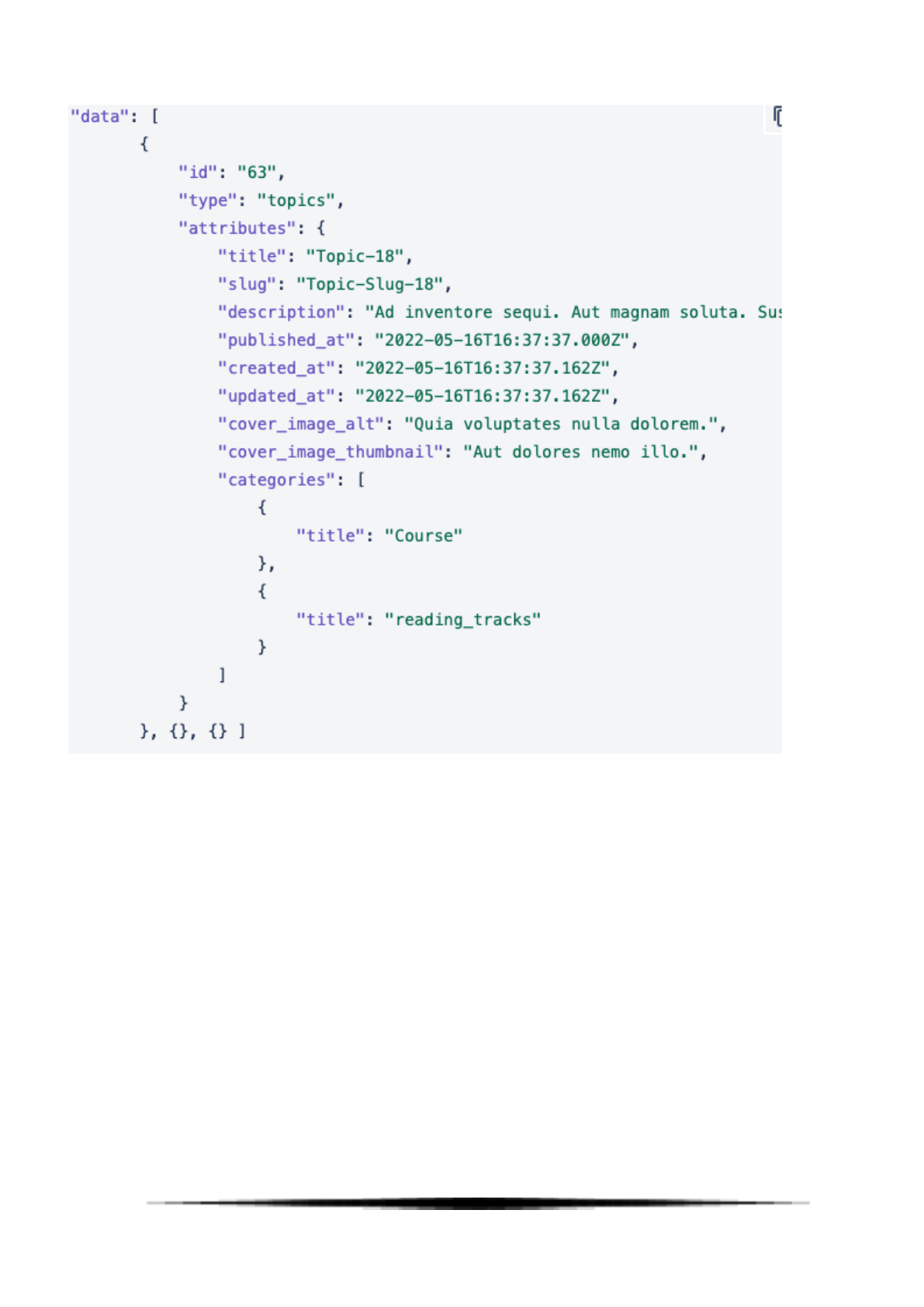
Fig 3.5 POST search/topics
● POST /topic/:slug/courses
30

Fig 3.6 POST /topic/:slug/courses
● POST /search/courses
31

Fig 3.7 POST search/courses
● GET course/:slug/modules
32

Fig 3.8 GET course/:slug/modules
33

3.8 Logic for Calculation for course progress
The logic for calculating of course progress is very simple. First you have to join the user_course_trackings
table which will have all the entities count for every course he/she will be viewing divided and join the
chapter_entities to count all the chapter_entities for that particular course having a where condition of the
chapter. Below is the detailed example
Course - C++
1. Introduction
a. what is c++
b. use case
c. scopes
d. history
e. future
2. Loops in C++
a. what is loop
b. for loop
c. while loop
d. do while loop
3. If/ else
a. what is if else
b. conditions
c. nested if else
d. else if
Chapter_counts = 3
Total entity count = 13
progress = Chapter_counts/ Total entity count
34

def query
relation.joins(:chapter_entities)
.joins("
LEFT JOIN user_course_trackings as uct ON uct.chapter_id = chapter_owners.chapter_id
")
.where("uct.course_id = #{options[:course_id]}
AND uct.user_id = #{options[:user_id]}
AND chapter_owners.owner_id = #{options[:course_id]}
AND chapter_owners.owner_type = 'Course'
")
.group('chapters.id')
end
def selector(current_query)
current_query.select('
chapters.title as title,
chapters.slug as slug,
ROUND((COUNT(DISTINCT (CASE when(uct.status = 1) then uct.id end))/COUNT(DISTINCT
chapter_entities.id))*100) as module_progress
')end
35

3.9 Logic for Calculation for video progress
The logic for calculating video progress is not very different from course progress. Actually we store the
duration of video in the database itself and we are constantly polling to the backend from the frontend. we are
using Vimeo SDK for sending request to the backend and extending support for the frontend
3.9.1 Vimeo SDK
The Vimeo player SDK is a short (but sweet) JavaScript library. We designed it to be easy to use and even
easier to access from HTML. There are only two ingredients:
● The link to the SDK
● An embedded Vimeo player
3.9.2 Accessing the player SDK
The easiest way to access the latest player SDK is to reference it directly from a <script> tag in your HTML.
Set the src attribute to https://player.vimeo.com/api/player.js.
Some points we considering
● Storing the time_elapsed of video in DB as well as in cookies
● Storing the notes in local storage if he doesn’t saves the notes in videos and closes the tab
36

BASIC CODE STRUCTURE
37
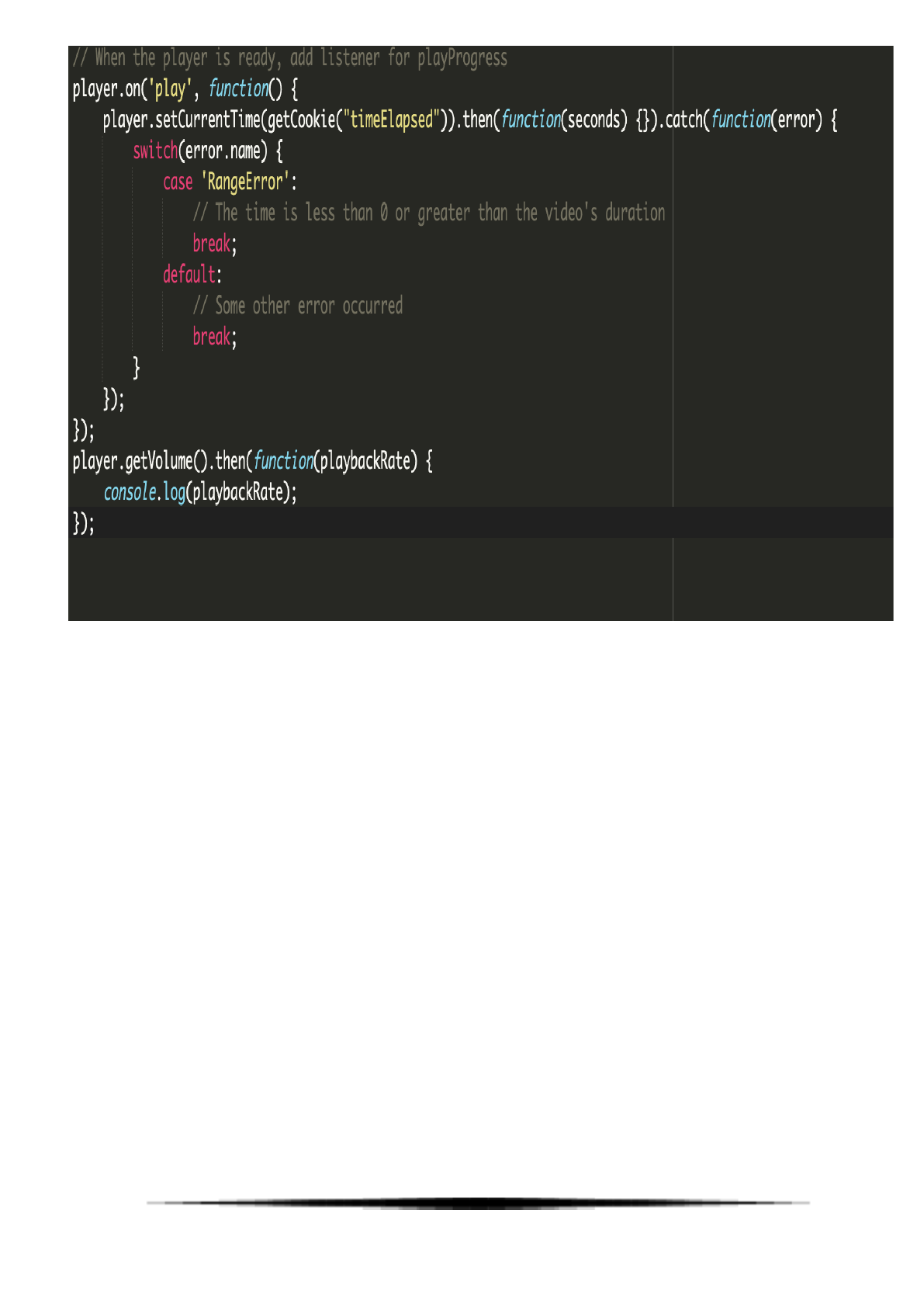
38

39

3.9.3 Calculation for Video Progress
we are sending all the time_elapsed from the above code by constantly polling to the backend
so we just need to calculate the progress by
progress_percentage = time_elpased/duration * 100
After that we are saving the progress_percentage and status for this particular video in user_course_trackings
table
we will be checking 2 conditions majorly for that
1. when time_elapsed > duration
Then the progress percentage will be 0 and status will be “pending”
2. when progress percentage > 90 %
will be setting status to complete
3. if a user rewatches a video
his highest progress will be taken and once status is “completed” then it will not change
We are sending progress_percentage as a hash that will contain status and progress percentage after
calculation for that particular video.
40

BASIC CODE STRUCTURE
def progress_metrics(time_elapsed:, entity_id: )
status = @model.status
progress_percentage = @model.progress_percentage
progress = Video.find_by(id: entity_id).progress_tracker.progress_percentage(time_elapsed: time_elapsed)
progress_hash = {
progress_percentage: [progress, progress_percentage].max,
status: status
}
if progress_hash[:progress_percentage] >= 90.0 && progress_hash[:status] == 'pending'
progress_hash[:status] = 'completed'
end
progress_hash
end
41

4. Performance Analysis
1. Seamless integration of new features in the existing Repository
Web developers appreciate Rails for their easy-to-navigate feature across various web forums. This
feature is supported by the Rails website migration. The Functional Model that highlights the default
Rails Active_record website can be easily extracted easily with the difference between different SQL
backgrounds. Instead of writing a schema in pure SQL language, we can use the transport feature that
allows us to use the simple Ruby DSL syntax to define changes to tables and records. As a result, RoR
allows for the creation of a database-agnostic schema and models that facilitate the migration of Rails
applications to different sites.
2. Traffic for the Website increased
As new features and interesting content was introduced to the existing site, user activity and
engagement have increased significantly.
3. Calculation of progress
Algorithmic approach that was discussed above was accurate up to .2 decimals and retrieving the
progress was efficient because using indexes in the user_course_trackings table.
4. Writing test cases using RSpec
RSpec is a Ruby system language testing module. RSpec is different from standard xUnit frameworks
like JUnit because it is a behavior-oriented development tool. This means that RSpec written tests
focus on the "behavior" of the test application. RSpec focuses on how the application works, not on
how it works, that is, what the application actually does.
Running RSpec on the existing code resulted in finding and eliminating any chance of bugs that would
cause unnecessary behaviors
42

5. Conclusions
The title of the thesis is “Development of Online Course Application with Ruby on Rails framework”. This
report described how the MVC architecture applies to the Web Community application under the Ruby on
Rails framework environment. Using the RoR technology, the application has been divided into smaller
components. Developing application functionality into modules has helped to separate stable code from
frequently changed one, to reuse source code, and to maintain and extend the application more easily.
The main objectives at the start of the thesis were as follows
● In designing and developing a data structure that can comprehensively define and hold each course's
properties.
● To design and develop a friendly user interface by which users of the system can interact with it in a
browser environment.
● The users must be able to see course contents.
● The users must be able to track their course progress.
● The users must be able to resume from the chapter where he leaves.
● The users must be able to find a particular course with name or title.
43

● The users must be able to take notes in between the courses.
At the end of the thesis the following things are achieved
● A front-end is developed for the client browser which is a system by which users can interact with the
application.
● A data structure that comprehensively defines and stores course details
● Once the user has logged in, he is able to see the progress of individual video/ course/ chapters
● Once the user has logged in, he is able to find all the courses he has been registered
● Once the user has logged in, he is able to resume the course from where he left
44

5.1 Future Scope
Further work involves continuing writing and executing tests, solving different errors and application bugs,
implementing unimplemented features. After securing and testing are finished, the application will be brought
to the production environment and will be deployed on the server
45

Appendix A - References
1. Dave Thomas, David Heinemeier Hansson: Agile Web Development with Rails Second Edition,
Pragmatic Bookshelf, ISBN 0-9776166-3-0
2. Dave Thomas, Chad Fowler and Andy Hunt: Programming Ruby Second Edition, Pragmatic
Bookshelf, ISBN 0-9745140-5-5
3. Andre Lewis, Michael Purvis, Jeffrey Sambells and Cameron Turner: Beginning Google Maps
Applications with Rails and AJAX, Apress, ISBN 1-59059-787-7
4. Andy Budd, Cameron Moll and Simon Collison: CSS Mastery, Friendsof, ISBN 1-59059-614-5
5. Ruby Documentation http://www.ruby-lang.org/en/
6. ROR Documentation http://rubyonrails.org/
7. http://thepaisano.files.wordpress.com/2008/04/rails2.png
8. http://rewrite.rickbradley.com/pages/moving_to_rails/
46

47

